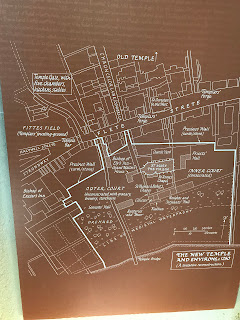Hidden in the side lanes of Fleet Street and Chancery Lane stands The Temple Church, built by the Knights Templar in 1163 and regarded for much of the Middle Ages as ‘London’s Jerusalem.’
The Temple Church was built at a time when Jerusalem was seen as the ‘centre of the world,’ and the most sacred place in Jerusalem was the round church of the Holy Sepulchre built over the empty tomb of Jesus. Pilgrims flocked to Jerusalem. For those who couldn’t, London now had an almost perfect copy. To be in the Templar ‘Round Church’ was to be in Jerusalem.
It's hard to visualise or overlay the extent of the Templar complex onto the roads and streets of modern London, but the map below may give you some idea.
And despite the Reformation, the Templar Church is still a substantial landmark in Abraham Hondius's Frost Fair on the Thames 1684. The Temple Church is on the right,
The Templars supported King John, and the Temple became John’s London headquarters 1214/15 during the Magna Carta crisis. Though it was signed at Runnymede, it was here he was advised to accept the Magna Carta by the powerful William Marshal I, his son William Marshal II and Brother Aymeric, Master of the Temple. A pivotal moment in English and American history and the first encounter between the Temple and the Law.
William Marshal I and William Marshal II
Father and Son
The Earl of Winchester. Easy to see why John was persuaded to sign the Magna Carta. Confronted with him, I'd have signed anything.
Above and below: Henry III.
Once a sacred site, the Temple Church is now a 'Royal Peculiar' and the preserve of lawyers—who may one day suffer the same fate as the Templars for much the same reason. In 1314 the Knights were suppressed. In 1608 James I gave the Temple to two of London’s ‘Inns of Court’ on two conditions: they would use it for the education and accommodation of lawyers and maintain the Temple Church in perpetuity. In fairness, they have done a remarkably good job.
The Temple was almost destroyed during the Blitz, but on the basis of numerous photographs and paintings, it was lovingly restored in fine detail. The bronze effigies of the Marshals, Kings John and Henry III are taken from casts made before the originals were destroyed by German bombs.
A forest of pillars, the Altar in the background
The roof of the rotunda, the circular balcony
and Altar in background
Steps to the balcony
Walking the balcony
Looking down at the effigies
The Altar's stained glass
The Church was refurbished in the Classical Style in the late C17th, in Gothic style in the 1840’s and in its present form after World War II. This may account for a feeling we both shared, that we were in a loved institution, a museum more than a church. For me it lacks spirit and soul, a sense of the sacred. Once ferociously religious, it has become opulent and sleek.


























No comments:
Post a Comment